University Project: System Analysis and Modelling for ETickets.com
VerifiedAdded on 2022/11/25
|15
|2280
|171
Project
AI Summary
This project provides a comprehensive system analysis and modeling for ETickets.com, an online bus booking service. The project begins with a business case, outlining problem descriptions, system capabilities, and anticipated business benefits. A detailed stakeholder analysis identifies and classifies relevant stakeholders, including bus operators, ticketing managers, software development managers, and customers. A rich picture visually represents the system, followed by an event table that outlines various events and their corresponding actions. A context diagram illustrates the system's boundaries and interactions. The project also includes assumptions made during the system's creation and concludes with a list of references. The analysis provides insights into the current system's processes and potential areas for improvement, offering a solid foundation for developing a new online ticketing system.
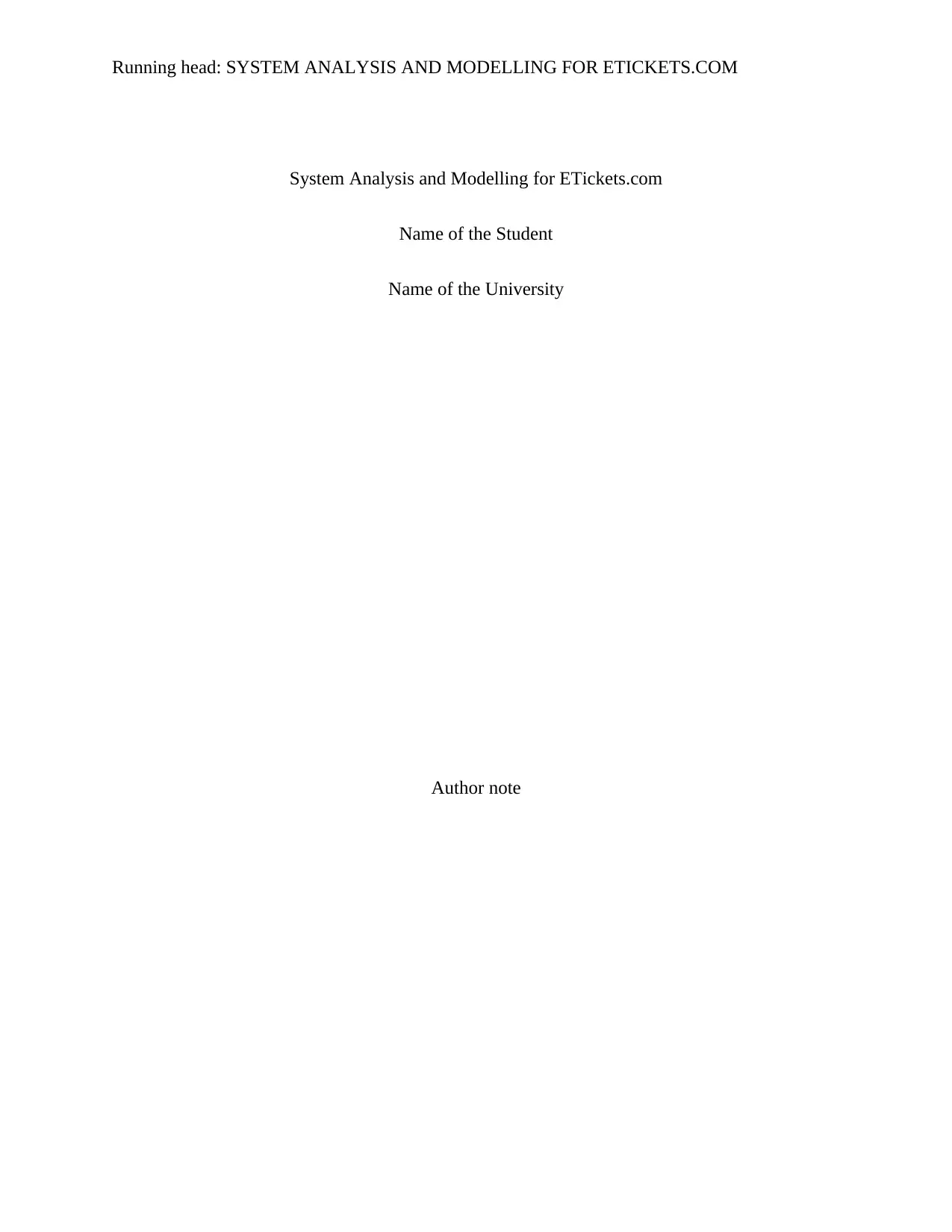
Running head: SYSTEM ANALYSIS AND MODELLING FOR ETICKETS.COM
System Analysis and Modelling for ETickets.com
Name of the Student
Name of the University
Author note
System Analysis and Modelling for ETickets.com
Name of the Student
Name of the University
Author note
Paraphrase This Document
Need a fresh take? Get an instant paraphrase of this document with our AI Paraphraser

1SYSTEM ANALYSIS AND MODELLING FOR ETICKETS.COM
Table of Contents
1. System vision or Business Case..................................................................................................2
1.1 Problem Description..............................................................................................................2
1.2 System Capabilities...............................................................................................................2
1.3 Anticipated Business Benefits...............................................................................................3
2. Stakeholder Analysis...................................................................................................................3
2.1 Identification and Description of Relevant Stakeholders......................................................3
2.2 Analysis and Classification of Stakeholders..........................................................................4
3. Rich Picture.................................................................................................................................8
4. Event Table..................................................................................................................................9
5. Context Diagram........................................................................................................................11
6. Assumptions..............................................................................................................................12
References......................................................................................................................................13
Table of Contents
1. System vision or Business Case..................................................................................................2
1.1 Problem Description..............................................................................................................2
1.2 System Capabilities...............................................................................................................2
1.3 Anticipated Business Benefits...............................................................................................3
2. Stakeholder Analysis...................................................................................................................3
2.1 Identification and Description of Relevant Stakeholders......................................................3
2.2 Analysis and Classification of Stakeholders..........................................................................4
3. Rich Picture.................................................................................................................................8
4. Event Table..................................................................................................................................9
5. Context Diagram........................................................................................................................11
6. Assumptions..............................................................................................................................12
References......................................................................................................................................13
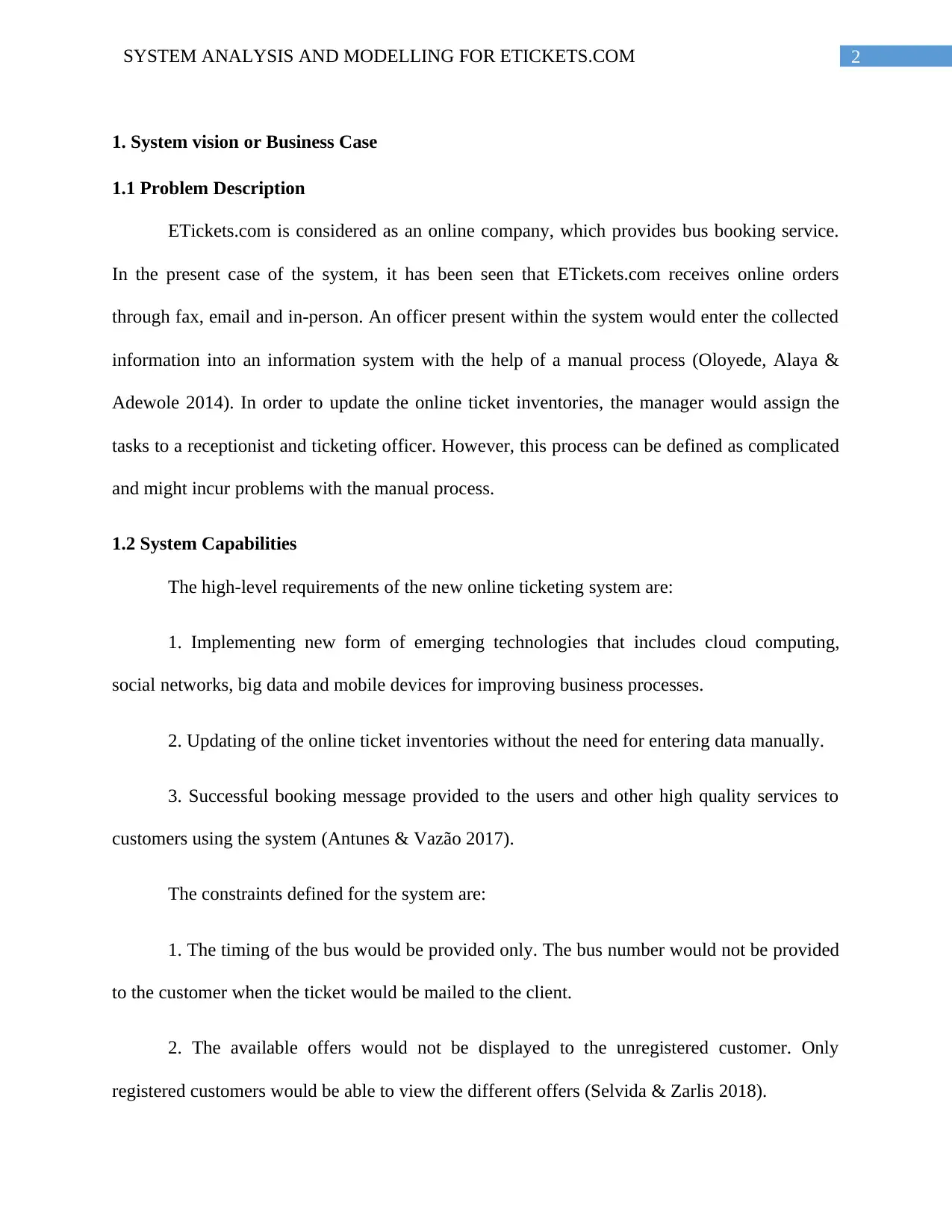
2SYSTEM ANALYSIS AND MODELLING FOR ETICKETS.COM
1. System vision or Business Case
1.1 Problem Description
ETickets.com is considered as an online company, which provides bus booking service.
In the present case of the system, it has been seen that ETickets.com receives online orders
through fax, email and in-person. An officer present within the system would enter the collected
information into an information system with the help of a manual process (Oloyede, Alaya &
Adewole 2014). In order to update the online ticket inventories, the manager would assign the
tasks to a receptionist and ticketing officer. However, this process can be defined as complicated
and might incur problems with the manual process.
1.2 System Capabilities
The high-level requirements of the new online ticketing system are:
1. Implementing new form of emerging technologies that includes cloud computing,
social networks, big data and mobile devices for improving business processes.
2. Updating of the online ticket inventories without the need for entering data manually.
3. Successful booking message provided to the users and other high quality services to
customers using the system (Antunes & Vazão 2017).
The constraints defined for the system are:
1. The timing of the bus would be provided only. The bus number would not be provided
to the customer when the ticket would be mailed to the client.
2. The available offers would not be displayed to the unregistered customer. Only
registered customers would be able to view the different offers (Selvida & Zarlis 2018).
1. System vision or Business Case
1.1 Problem Description
ETickets.com is considered as an online company, which provides bus booking service.
In the present case of the system, it has been seen that ETickets.com receives online orders
through fax, email and in-person. An officer present within the system would enter the collected
information into an information system with the help of a manual process (Oloyede, Alaya &
Adewole 2014). In order to update the online ticket inventories, the manager would assign the
tasks to a receptionist and ticketing officer. However, this process can be defined as complicated
and might incur problems with the manual process.
1.2 System Capabilities
The high-level requirements of the new online ticketing system are:
1. Implementing new form of emerging technologies that includes cloud computing,
social networks, big data and mobile devices for improving business processes.
2. Updating of the online ticket inventories without the need for entering data manually.
3. Successful booking message provided to the users and other high quality services to
customers using the system (Antunes & Vazão 2017).
The constraints defined for the system are:
1. The timing of the bus would be provided only. The bus number would not be provided
to the customer when the ticket would be mailed to the client.
2. The available offers would not be displayed to the unregistered customer. Only
registered customers would be able to view the different offers (Selvida & Zarlis 2018).
⊘ This is a preview!⊘
Do you want full access?
Subscribe today to unlock all pages.

Trusted by 1+ million students worldwide
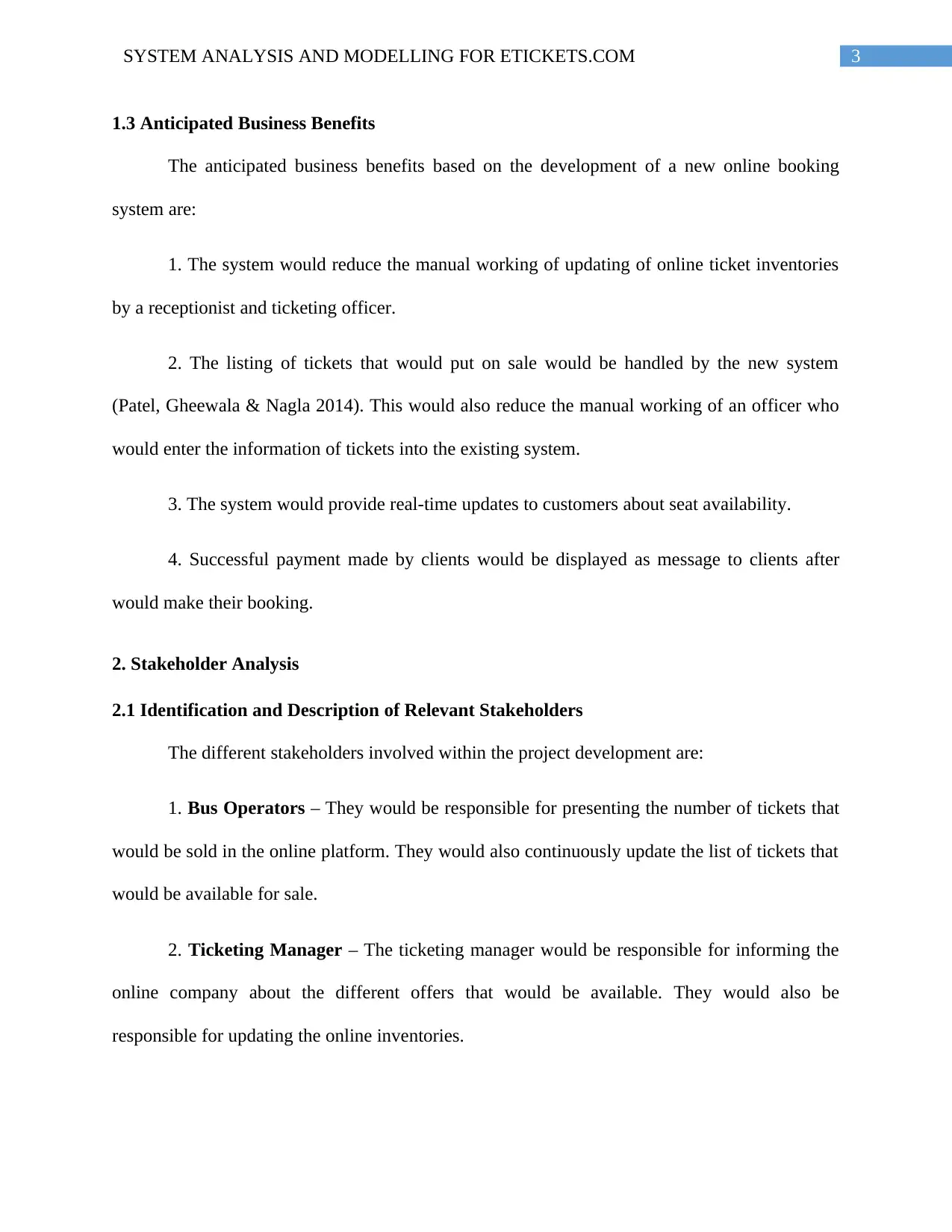
3SYSTEM ANALYSIS AND MODELLING FOR ETICKETS.COM
1.3 Anticipated Business Benefits
The anticipated business benefits based on the development of a new online booking
system are:
1. The system would reduce the manual working of updating of online ticket inventories
by a receptionist and ticketing officer.
2. The listing of tickets that would put on sale would be handled by the new system
(Patel, Gheewala & Nagla 2014). This would also reduce the manual working of an officer who
would enter the information of tickets into the existing system.
3. The system would provide real-time updates to customers about seat availability.
4. Successful payment made by clients would be displayed as message to clients after
would make their booking.
2. Stakeholder Analysis
2.1 Identification and Description of Relevant Stakeholders
The different stakeholders involved within the project development are:
1. Bus Operators – They would be responsible for presenting the number of tickets that
would be sold in the online platform. They would also continuously update the list of tickets that
would be available for sale.
2. Ticketing Manager – The ticketing manager would be responsible for informing the
online company about the different offers that would be available. They would also be
responsible for updating the online inventories.
1.3 Anticipated Business Benefits
The anticipated business benefits based on the development of a new online booking
system are:
1. The system would reduce the manual working of updating of online ticket inventories
by a receptionist and ticketing officer.
2. The listing of tickets that would put on sale would be handled by the new system
(Patel, Gheewala & Nagla 2014). This would also reduce the manual working of an officer who
would enter the information of tickets into the existing system.
3. The system would provide real-time updates to customers about seat availability.
4. Successful payment made by clients would be displayed as message to clients after
would make their booking.
2. Stakeholder Analysis
2.1 Identification and Description of Relevant Stakeholders
The different stakeholders involved within the project development are:
1. Bus Operators – They would be responsible for presenting the number of tickets that
would be sold in the online platform. They would also continuously update the list of tickets that
would be available for sale.
2. Ticketing Manager – The ticketing manager would be responsible for informing the
online company about the different offers that would be available. They would also be
responsible for updating the online inventories.
Paraphrase This Document
Need a fresh take? Get an instant paraphrase of this document with our AI Paraphraser

4SYSTEM ANALYSIS AND MODELLING FOR ETICKETS.COM
3. Software Development Manager – They would develop the software based on
understanding the present system and including new technologies within the present system.
New technologies such as big data, cloud computing and many others would also be
implemented by them.
4. Customers – The customers would book tickets for the bus with the help of the new
system (Zhou et al. 2019). They would register themselves within the website and then book
tickets based on the availability of tickets.
2.2 Analysis and Classification of Stakeholders
Stakeholders Power of
Stakeholders
Influence over the Project Interest Level
Bus
Operators
Medium They would define the operations
performed by them and which
needs to be implemented by the
software engineers within the new
design.
High
Ticketing
Manager
High They would ensure that the online
offers, which are manually
handled by them should be
included within the new system.
High
Software
Development
Manager
Medium To ensure each of the inclusions
within the project would be
handled efficiently be them. Thus,
they would solely responsible for
maintenance of the software
system after their deployment.
Medium
Customers Low They would ensure that each if the
system components would work
properly. Any kind of problems
faced by them should be reported
to the development team directly.
Medium
3. Software Development Manager – They would develop the software based on
understanding the present system and including new technologies within the present system.
New technologies such as big data, cloud computing and many others would also be
implemented by them.
4. Customers – The customers would book tickets for the bus with the help of the new
system (Zhou et al. 2019). They would register themselves within the website and then book
tickets based on the availability of tickets.
2.2 Analysis and Classification of Stakeholders
Stakeholders Power of
Stakeholders
Influence over the Project Interest Level
Bus
Operators
Medium They would define the operations
performed by them and which
needs to be implemented by the
software engineers within the new
design.
High
Ticketing
Manager
High They would ensure that the online
offers, which are manually
handled by them should be
included within the new system.
High
Software
Development
Manager
Medium To ensure each of the inclusions
within the project would be
handled efficiently be them. Thus,
they would solely responsible for
maintenance of the software
system after their deployment.
Medium
Customers Low They would ensure that each if the
system components would work
properly. Any kind of problems
faced by them should be reported
to the development team directly.
Medium
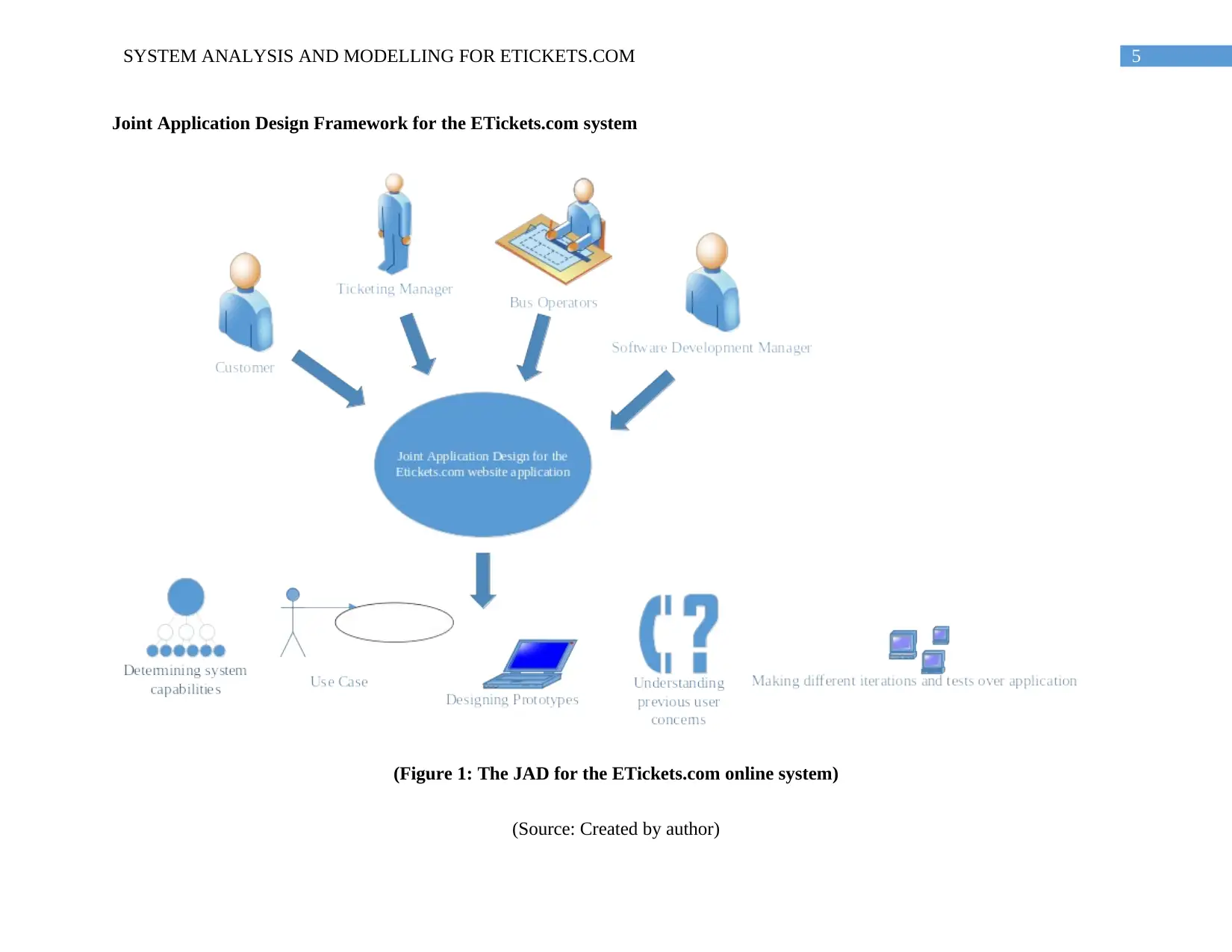
5SYSTEM ANALYSIS AND MODELLING FOR ETICKETS.COM
Joint Application Design Framework for the ETickets.com system
(Figure 1: The JAD for the ETickets.com online system)
(Source: Created by author)
Joint Application Design Framework for the ETickets.com system
(Figure 1: The JAD for the ETickets.com online system)
(Source: Created by author)
⊘ This is a preview!⊘
Do you want full access?
Subscribe today to unlock all pages.

Trusted by 1+ million students worldwide
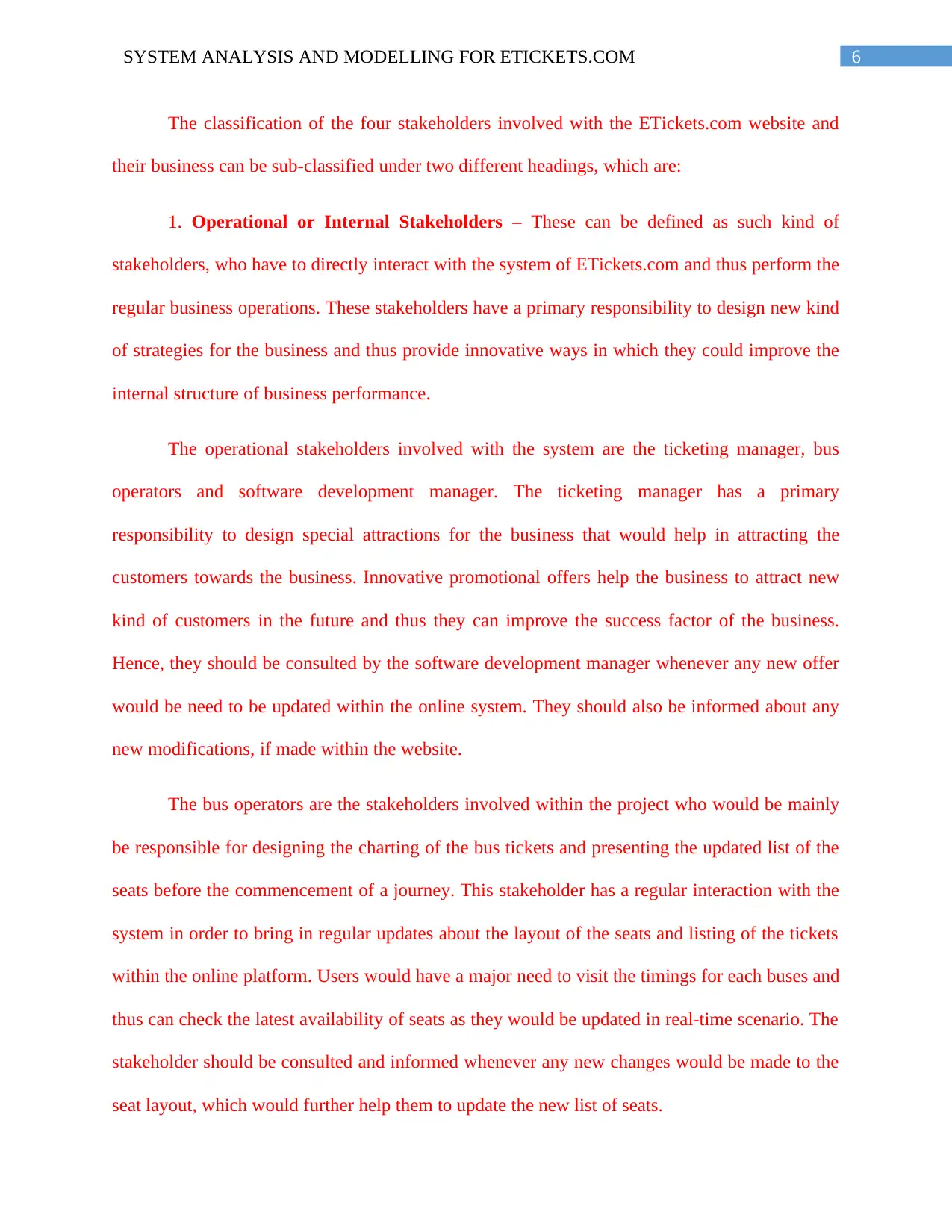
6SYSTEM ANALYSIS AND MODELLING FOR ETICKETS.COM
The classification of the four stakeholders involved with the ETickets.com website and
their business can be sub-classified under two different headings, which are:
1. Operational or Internal Stakeholders – These can be defined as such kind of
stakeholders, who have to directly interact with the system of ETickets.com and thus perform the
regular business operations. These stakeholders have a primary responsibility to design new kind
of strategies for the business and thus provide innovative ways in which they could improve the
internal structure of business performance.
The operational stakeholders involved with the system are the ticketing manager, bus
operators and software development manager. The ticketing manager has a primary
responsibility to design special attractions for the business that would help in attracting the
customers towards the business. Innovative promotional offers help the business to attract new
kind of customers in the future and thus they can improve the success factor of the business.
Hence, they should be consulted by the software development manager whenever any new offer
would be need to be updated within the online system. They should also be informed about any
new modifications, if made within the website.
The bus operators are the stakeholders involved within the project who would be mainly
be responsible for designing the charting of the bus tickets and presenting the updated list of the
seats before the commencement of a journey. This stakeholder has a regular interaction with the
system in order to bring in regular updates about the layout of the seats and listing of the tickets
within the online platform. Users would have a major need to visit the timings for each buses and
thus can check the latest availability of seats as they would be updated in real-time scenario. The
stakeholder should be consulted and informed whenever any new changes would be made to the
seat layout, which would further help them to update the new list of seats.
The classification of the four stakeholders involved with the ETickets.com website and
their business can be sub-classified under two different headings, which are:
1. Operational or Internal Stakeholders – These can be defined as such kind of
stakeholders, who have to directly interact with the system of ETickets.com and thus perform the
regular business operations. These stakeholders have a primary responsibility to design new kind
of strategies for the business and thus provide innovative ways in which they could improve the
internal structure of business performance.
The operational stakeholders involved with the system are the ticketing manager, bus
operators and software development manager. The ticketing manager has a primary
responsibility to design special attractions for the business that would help in attracting the
customers towards the business. Innovative promotional offers help the business to attract new
kind of customers in the future and thus they can improve the success factor of the business.
Hence, they should be consulted by the software development manager whenever any new offer
would be need to be updated within the online system. They should also be informed about any
new modifications, if made within the website.
The bus operators are the stakeholders involved within the project who would be mainly
be responsible for designing the charting of the bus tickets and presenting the updated list of the
seats before the commencement of a journey. This stakeholder has a regular interaction with the
system in order to bring in regular updates about the layout of the seats and listing of the tickets
within the online platform. Users would have a major need to visit the timings for each buses and
thus can check the latest availability of seats as they would be updated in real-time scenario. The
stakeholder should be consulted and informed whenever any new changes would be made to the
seat layout, which would further help them to update the new list of seats.
Paraphrase This Document
Need a fresh take? Get an instant paraphrase of this document with our AI Paraphraser
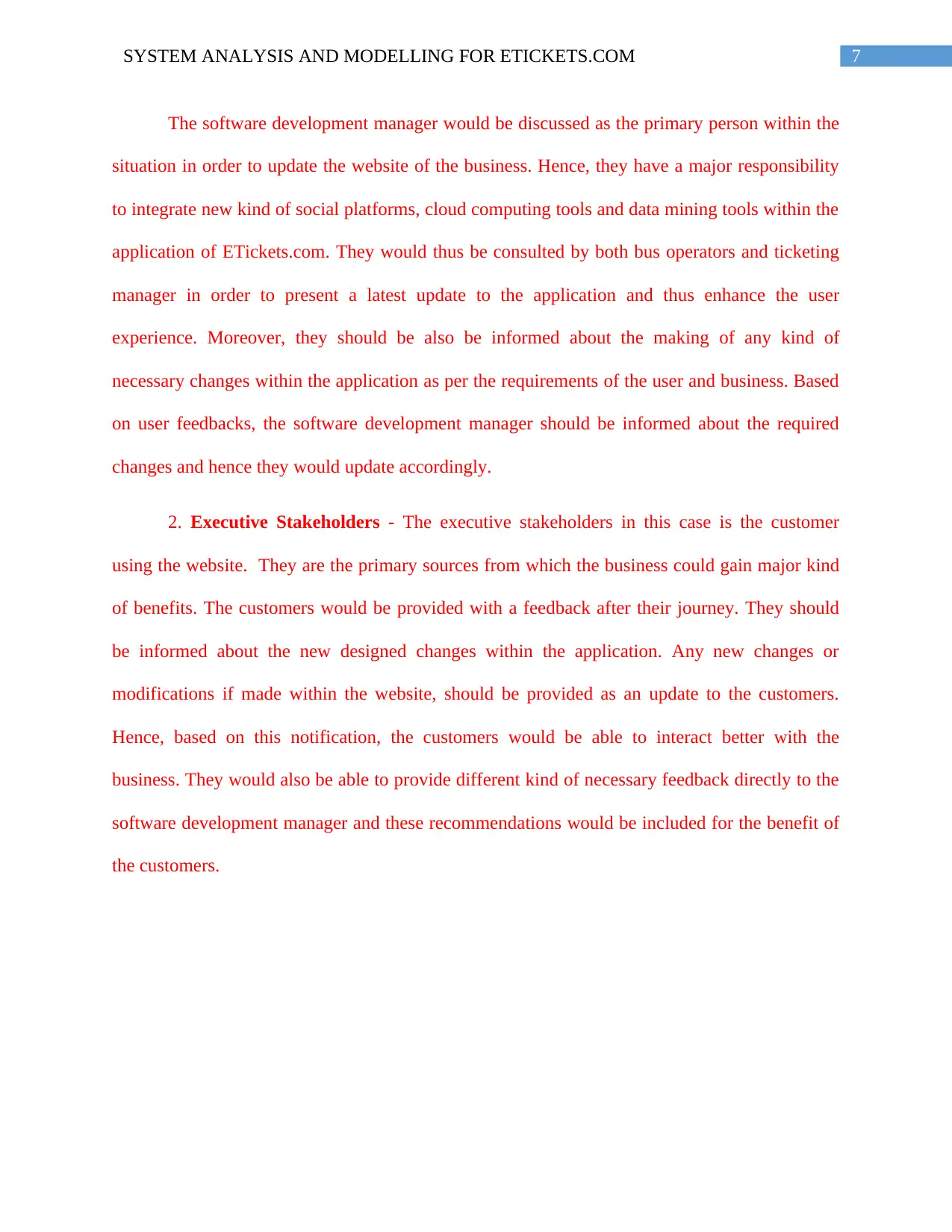
7SYSTEM ANALYSIS AND MODELLING FOR ETICKETS.COM
The software development manager would be discussed as the primary person within the
situation in order to update the website of the business. Hence, they have a major responsibility
to integrate new kind of social platforms, cloud computing tools and data mining tools within the
application of ETickets.com. They would thus be consulted by both bus operators and ticketing
manager in order to present a latest update to the application and thus enhance the user
experience. Moreover, they should be also be informed about the making of any kind of
necessary changes within the application as per the requirements of the user and business. Based
on user feedbacks, the software development manager should be informed about the required
changes and hence they would update accordingly.
2. Executive Stakeholders - The executive stakeholders in this case is the customer
using the website. They are the primary sources from which the business could gain major kind
of benefits. The customers would be provided with a feedback after their journey. They should
be informed about the new designed changes within the application. Any new changes or
modifications if made within the website, should be provided as an update to the customers.
Hence, based on this notification, the customers would be able to interact better with the
business. They would also be able to provide different kind of necessary feedback directly to the
software development manager and these recommendations would be included for the benefit of
the customers.
The software development manager would be discussed as the primary person within the
situation in order to update the website of the business. Hence, they have a major responsibility
to integrate new kind of social platforms, cloud computing tools and data mining tools within the
application of ETickets.com. They would thus be consulted by both bus operators and ticketing
manager in order to present a latest update to the application and thus enhance the user
experience. Moreover, they should be also be informed about the making of any kind of
necessary changes within the application as per the requirements of the user and business. Based
on user feedbacks, the software development manager should be informed about the required
changes and hence they would update accordingly.
2. Executive Stakeholders - The executive stakeholders in this case is the customer
using the website. They are the primary sources from which the business could gain major kind
of benefits. The customers would be provided with a feedback after their journey. They should
be informed about the new designed changes within the application. Any new changes or
modifications if made within the website, should be provided as an update to the customers.
Hence, based on this notification, the customers would be able to interact better with the
business. They would also be able to provide different kind of necessary feedback directly to the
software development manager and these recommendations would be included for the benefit of
the customers.

8SYSTEM ANALYSIS AND MODELLING FOR ETICKETS.COM
3. Rich Picture
(Figure 2: The Rich Picture for the ETickets.com online system)
(Source: Created by author)
3. Rich Picture
(Figure 2: The Rich Picture for the ETickets.com online system)
(Source: Created by author)
⊘ This is a preview!⊘
Do you want full access?
Subscribe today to unlock all pages.

Trusted by 1+ million students worldwide
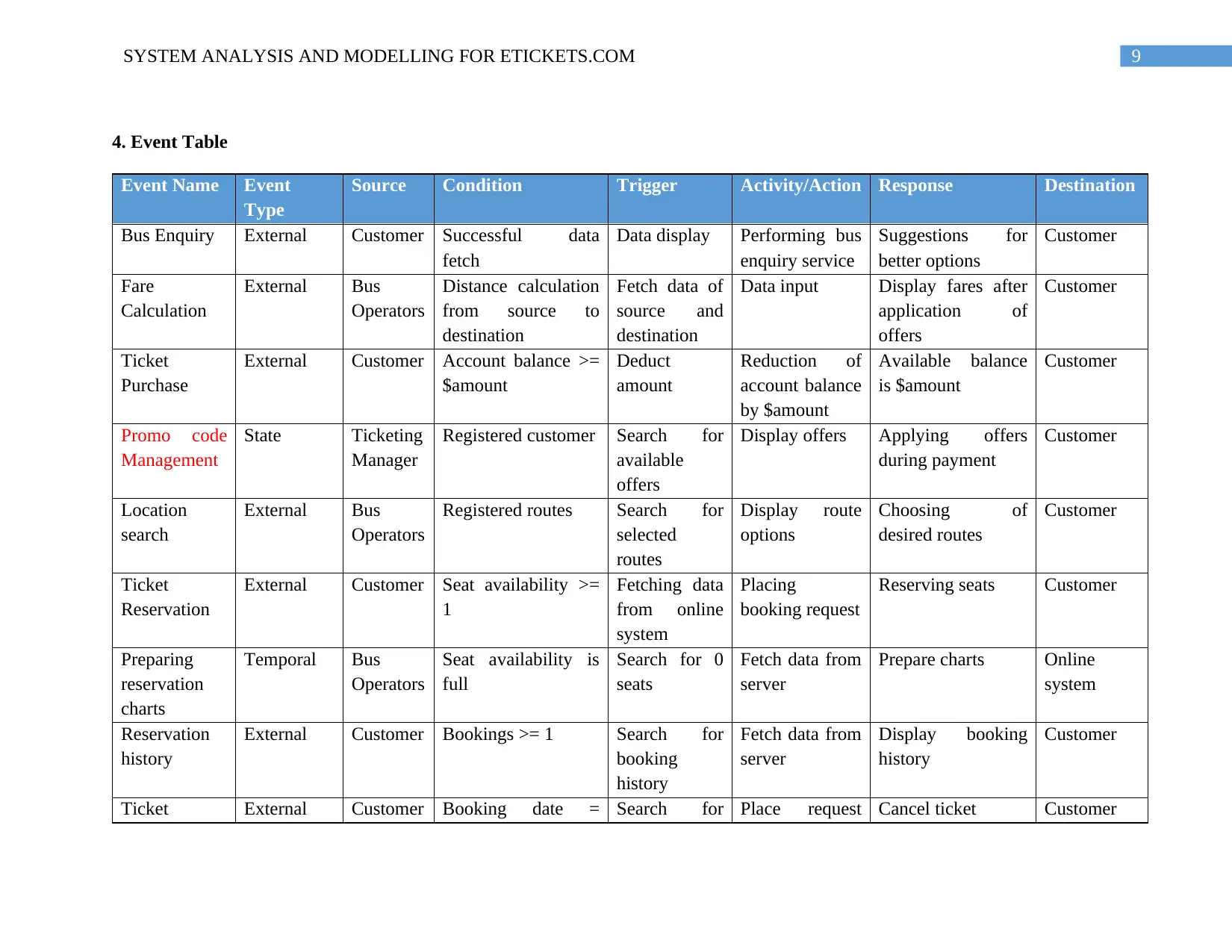
9SYSTEM ANALYSIS AND MODELLING FOR ETICKETS.COM
4. Event Table
Event Name Event
Type
Source Condition Trigger Activity/Action Response Destination
Bus Enquiry External Customer Successful data
fetch
Data display Performing bus
enquiry service
Suggestions for
better options
Customer
Fare
Calculation
External Bus
Operators
Distance calculation
from source to
destination
Fetch data of
source and
destination
Data input Display fares after
application of
offers
Customer
Ticket
Purchase
External Customer Account balance >=
$amount
Deduct
amount
Reduction of
account balance
by $amount
Available balance
is $amount
Customer
Promo code
Management
State Ticketing
Manager
Registered customer Search for
available
offers
Display offers Applying offers
during payment
Customer
Location
search
External Bus
Operators
Registered routes Search for
selected
routes
Display route
options
Choosing of
desired routes
Customer
Ticket
Reservation
External Customer Seat availability >=
1
Fetching data
from online
system
Placing
booking request
Reserving seats Customer
Preparing
reservation
charts
Temporal Bus
Operators
Seat availability is
full
Search for 0
seats
Fetch data from
server
Prepare charts Online
system
Reservation
history
External Customer Bookings >= 1 Search for
booking
history
Fetch data from
server
Display booking
history
Customer
Ticket External Customer Booking date = Search for Place request Cancel ticket Customer
4. Event Table
Event Name Event
Type
Source Condition Trigger Activity/Action Response Destination
Bus Enquiry External Customer Successful data
fetch
Data display Performing bus
enquiry service
Suggestions for
better options
Customer
Fare
Calculation
External Bus
Operators
Distance calculation
from source to
destination
Fetch data of
source and
destination
Data input Display fares after
application of
offers
Customer
Ticket
Purchase
External Customer Account balance >=
$amount
Deduct
amount
Reduction of
account balance
by $amount
Available balance
is $amount
Customer
Promo code
Management
State Ticketing
Manager
Registered customer Search for
available
offers
Display offers Applying offers
during payment
Customer
Location
search
External Bus
Operators
Registered routes Search for
selected
routes
Display route
options
Choosing of
desired routes
Customer
Ticket
Reservation
External Customer Seat availability >=
1
Fetching data
from online
system
Placing
booking request
Reserving seats Customer
Preparing
reservation
charts
Temporal Bus
Operators
Seat availability is
full
Search for 0
seats
Fetch data from
server
Prepare charts Online
system
Reservation
history
External Customer Bookings >= 1 Search for
booking
history
Fetch data from
server
Display booking
history
Customer
Ticket External Customer Booking date = Search for Place request Cancel ticket Customer
Paraphrase This Document
Need a fresh take? Get an instant paraphrase of this document with our AI Paraphraser
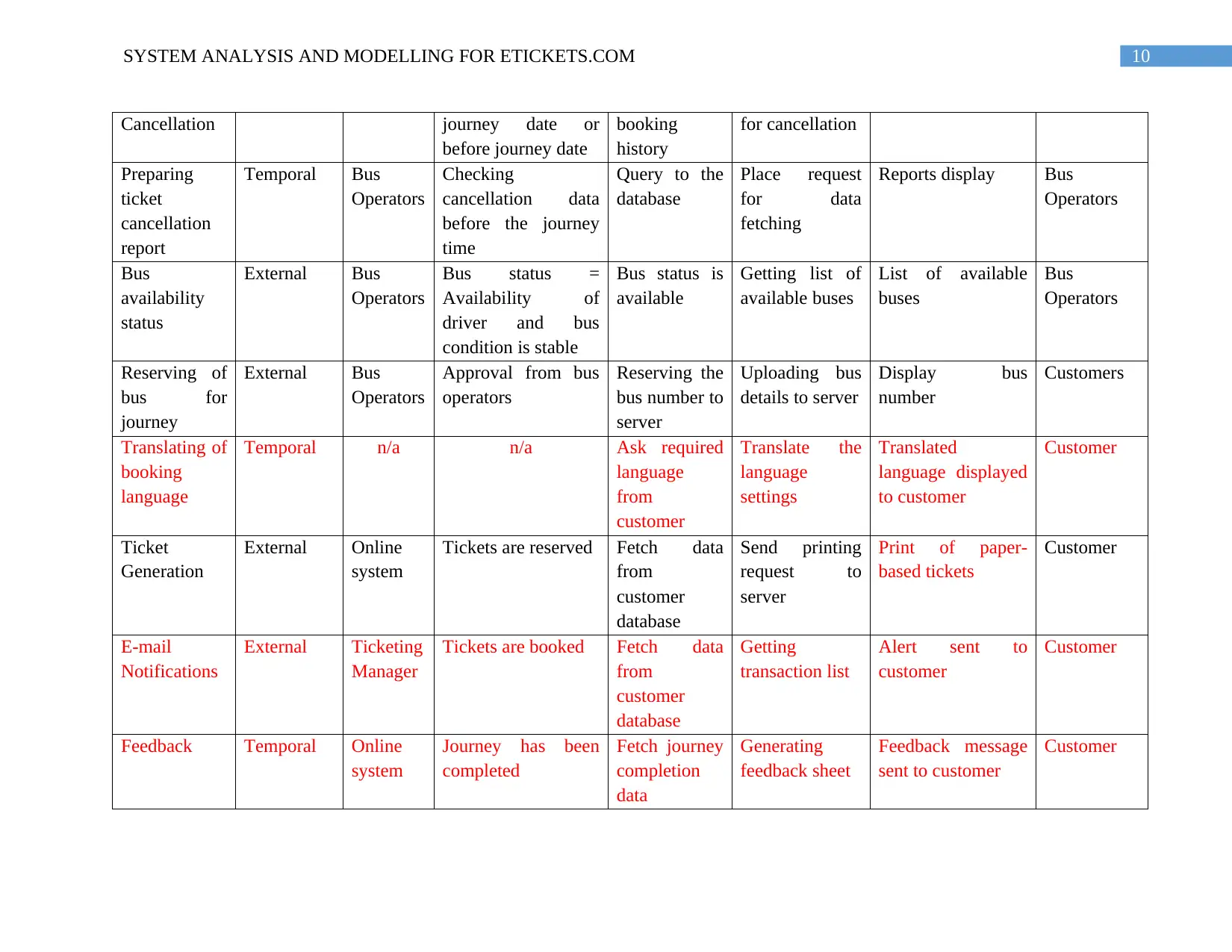
10SYSTEM ANALYSIS AND MODELLING FOR ETICKETS.COM
Cancellation journey date or
before journey date
booking
history
for cancellation
Preparing
ticket
cancellation
report
Temporal Bus
Operators
Checking
cancellation data
before the journey
time
Query to the
database
Place request
for data
fetching
Reports display Bus
Operators
Bus
availability
status
External Bus
Operators
Bus status =
Availability of
driver and bus
condition is stable
Bus status is
available
Getting list of
available buses
List of available
buses
Bus
Operators
Reserving of
bus for
journey
External Bus
Operators
Approval from bus
operators
Reserving the
bus number to
server
Uploading bus
details to server
Display bus
number
Customers
Translating of
booking
language
Temporal n/a n/a Ask required
language
from
customer
Translate the
language
settings
Translated
language displayed
to customer
Customer
Ticket
Generation
External Online
system
Tickets are reserved Fetch data
from
customer
database
Send printing
request to
server
Print of paper-
based tickets
Customer
E-mail
Notifications
External Ticketing
Manager
Tickets are booked Fetch data
from
customer
database
Getting
transaction list
Alert sent to
customer
Customer
Feedback Temporal Online
system
Journey has been
completed
Fetch journey
completion
data
Generating
feedback sheet
Feedback message
sent to customer
Customer
Cancellation journey date or
before journey date
booking
history
for cancellation
Preparing
ticket
cancellation
report
Temporal Bus
Operators
Checking
cancellation data
before the journey
time
Query to the
database
Place request
for data
fetching
Reports display Bus
Operators
Bus
availability
status
External Bus
Operators
Bus status =
Availability of
driver and bus
condition is stable
Bus status is
available
Getting list of
available buses
List of available
buses
Bus
Operators
Reserving of
bus for
journey
External Bus
Operators
Approval from bus
operators
Reserving the
bus number to
server
Uploading bus
details to server
Display bus
number
Customers
Translating of
booking
language
Temporal n/a n/a Ask required
language
from
customer
Translate the
language
settings
Translated
language displayed
to customer
Customer
Ticket
Generation
External Online
system
Tickets are reserved Fetch data
from
customer
database
Send printing
request to
server
Print of paper-
based tickets
Customer
Notifications
External Ticketing
Manager
Tickets are booked Fetch data
from
customer
database
Getting
transaction list
Alert sent to
customer
Customer
Feedback Temporal Online
system
Journey has been
completed
Fetch journey
completion
data
Generating
feedback sheet
Feedback message
sent to customer
Customer

11SYSTEM ANALYSIS AND MODELLING FOR ETICKETS.COM
5. Context Diagram
(Figure 3: The Context Diagram for the ETickets.com online system)
5. Context Diagram
(Figure 3: The Context Diagram for the ETickets.com online system)
⊘ This is a preview!⊘
Do you want full access?
Subscribe today to unlock all pages.

Trusted by 1+ million students worldwide
1 out of 15
Related Documents
Your All-in-One AI-Powered Toolkit for Academic Success.
+13062052269
info@desklib.com
Available 24*7 on WhatsApp / Email
![[object Object]](/_next/static/media/star-bottom.7253800d.svg)
Unlock your academic potential
Copyright © 2020–2025 A2Z Services. All Rights Reserved. Developed and managed by ZUCOL.





